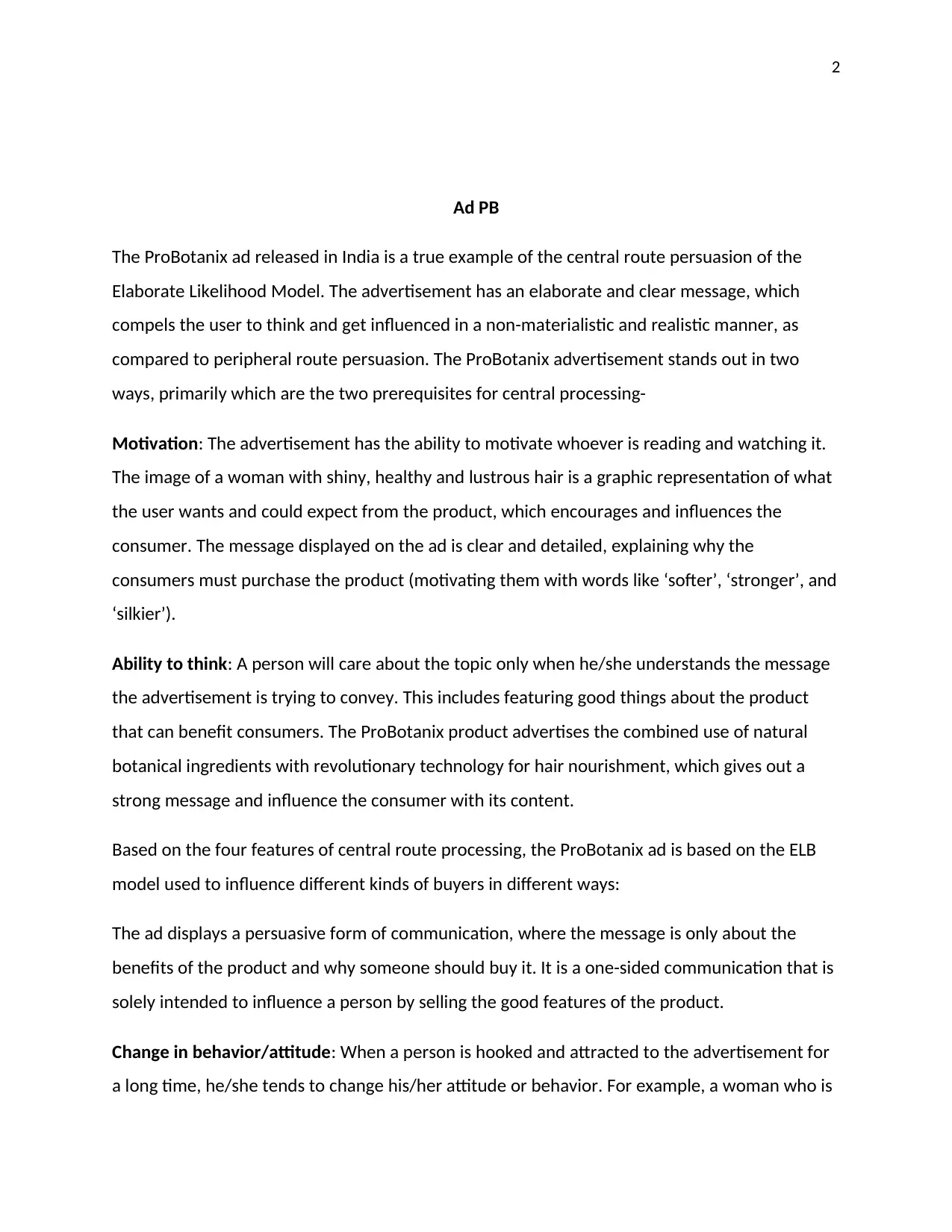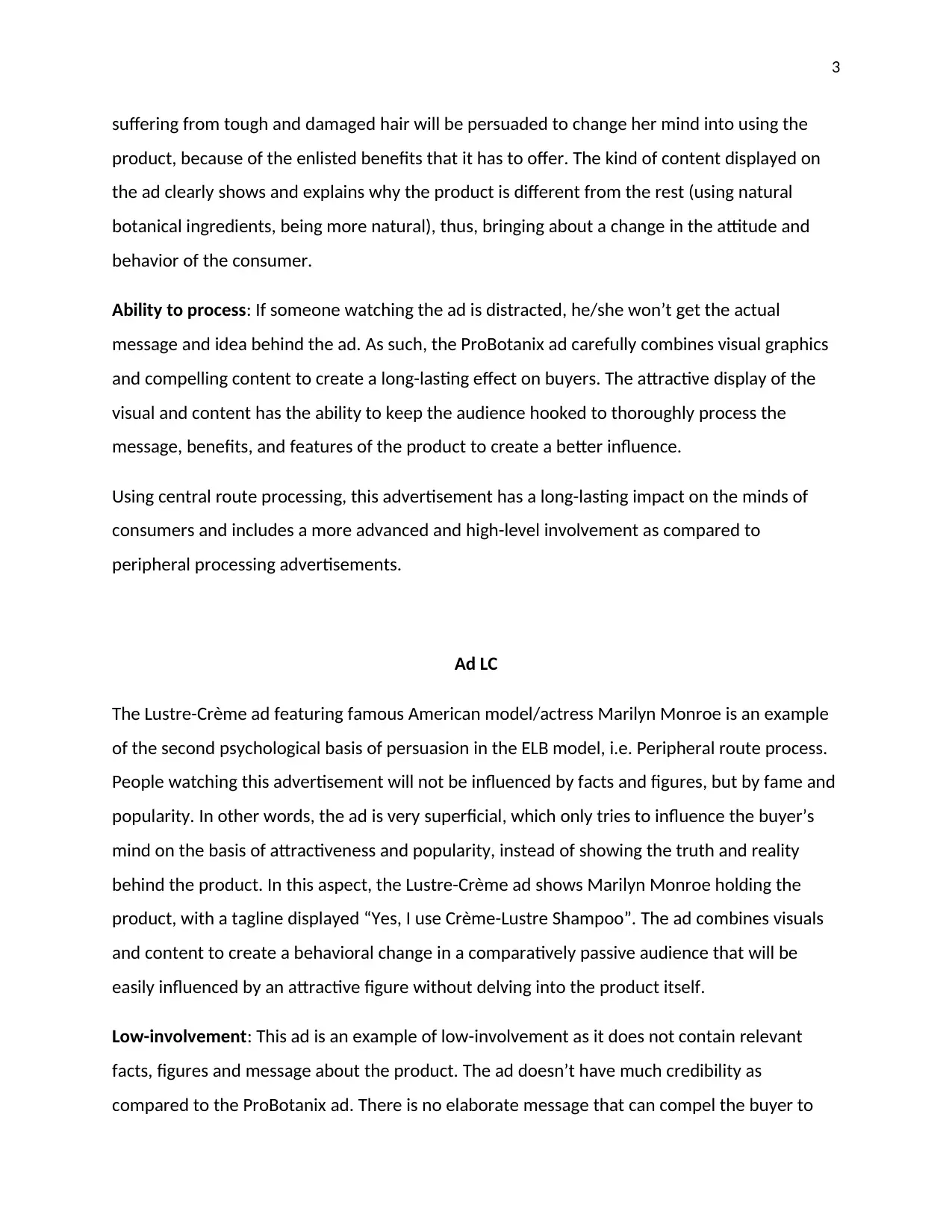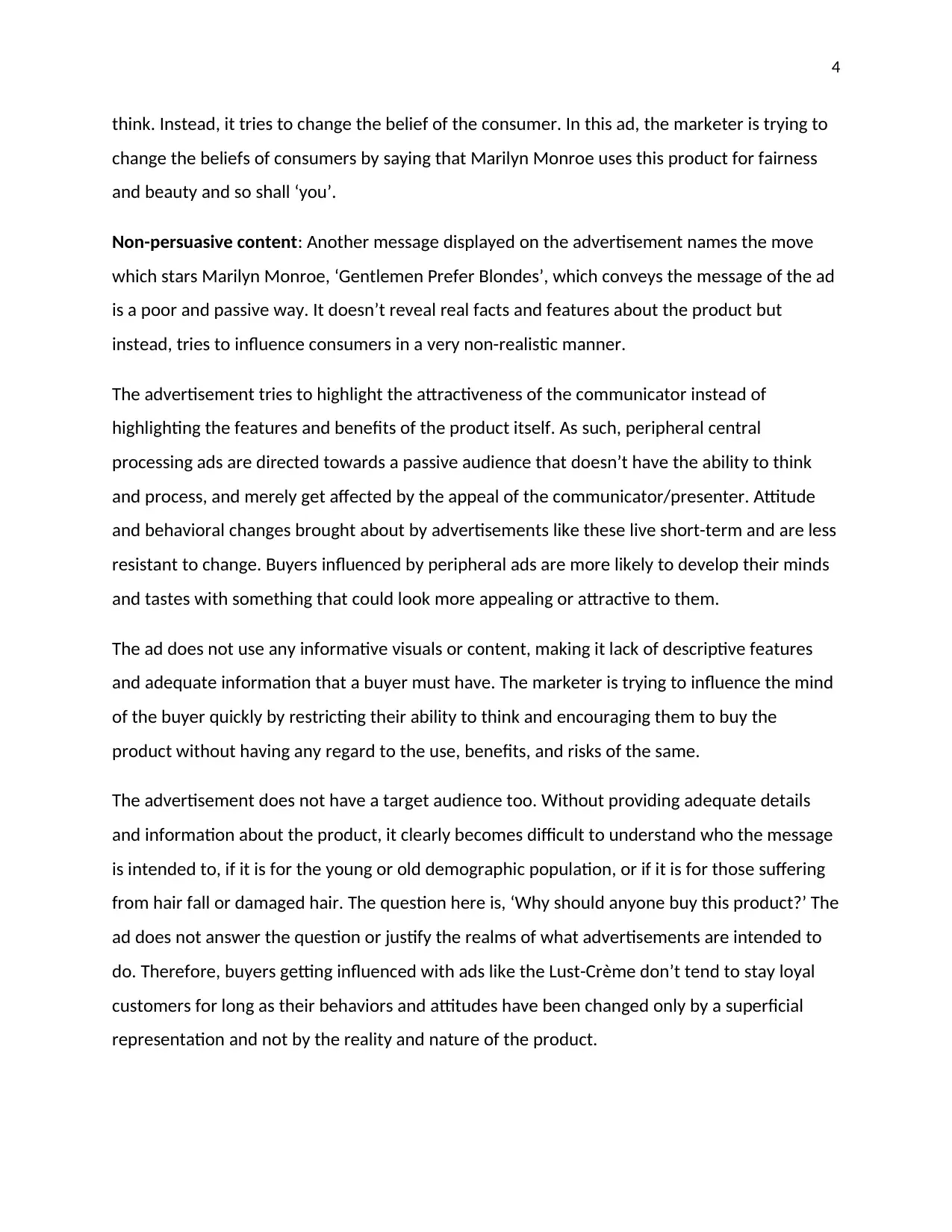Consumer Behaviour: ELM Analysis of ProBotanix & Lustre-Crème Ads
VerifiedAdded on 2023/06/07
|4
|1157
|470
Essay
AI Summary
This essay provides an analysis of two advertisements, ProBotanix and Lustre-Crème, through the lens of the Elaboration Likelihood Model (ELM). It distinguishes between central and peripheral routes of persuasion, arguing that the ProBotanix ad exemplifies central route processing due to its detailed and motivating message focused on product benefits and consumer engagement. Conversely, the Lustre-Crème ad is presented as an example of peripheral route processing, relying on celebrity endorsement (Marilyn Monroe) and superficial appeal rather than factual information about the product. The essay highlights how the ProBotanix ad fosters a lasting impact through high-level involvement, while the Lustre-Crème ad generates short-term attitude changes based on attractiveness and popularity, ultimately influencing consumer loyalty and behavior differently. The analysis emphasizes the importance of informative content and targeted messaging in effective advertising strategies.

Part 2
Consumer Behavior
Student Name
University Name
Consumer Behavior
Student Name
University Name
Paraphrase This Document
Need a fresh take? Get an instant paraphrase of this document with our AI Paraphraser

2
Ad PB
The ProBotanix ad released in India is a true example of the central route persuasion of the
Elaborate Likelihood Model. The advertisement has an elaborate and clear message, which
compels the user to think and get influenced in a non-materialistic and realistic manner, as
compared to peripheral route persuasion. The ProBotanix advertisement stands out in two
ways, primarily which are the two prerequisites for central processing-
Motivation: The advertisement has the ability to motivate whoever is reading and watching it.
The image of a woman with shiny, healthy and lustrous hair is a graphic representation of what
the user wants and could expect from the product, which encourages and influences the
consumer. The message displayed on the ad is clear and detailed, explaining why the
consumers must purchase the product (motivating them with words like ‘softer’, ‘stronger’, and
‘silkier’).
Ability to think: A person will care about the topic only when he/she understands the message
the advertisement is trying to convey. This includes featuring good things about the product
that can benefit consumers. The ProBotanix product advertises the combined use of natural
botanical ingredients with revolutionary technology for hair nourishment, which gives out a
strong message and influence the consumer with its content.
Based on the four features of central route processing, the ProBotanix ad is based on the ELB
model used to influence different kinds of buyers in different ways:
The ad displays a persuasive form of communication, where the message is only about the
benefits of the product and why someone should buy it. It is a one-sided communication that is
solely intended to influence a person by selling the good features of the product.
Change in behavior/attitude: When a person is hooked and attracted to the advertisement for
a long time, he/she tends to change his/her attitude or behavior. For example, a woman who is
Ad PB
The ProBotanix ad released in India is a true example of the central route persuasion of the
Elaborate Likelihood Model. The advertisement has an elaborate and clear message, which
compels the user to think and get influenced in a non-materialistic and realistic manner, as
compared to peripheral route persuasion. The ProBotanix advertisement stands out in two
ways, primarily which are the two prerequisites for central processing-
Motivation: The advertisement has the ability to motivate whoever is reading and watching it.
The image of a woman with shiny, healthy and lustrous hair is a graphic representation of what
the user wants and could expect from the product, which encourages and influences the
consumer. The message displayed on the ad is clear and detailed, explaining why the
consumers must purchase the product (motivating them with words like ‘softer’, ‘stronger’, and
‘silkier’).
Ability to think: A person will care about the topic only when he/she understands the message
the advertisement is trying to convey. This includes featuring good things about the product
that can benefit consumers. The ProBotanix product advertises the combined use of natural
botanical ingredients with revolutionary technology for hair nourishment, which gives out a
strong message and influence the consumer with its content.
Based on the four features of central route processing, the ProBotanix ad is based on the ELB
model used to influence different kinds of buyers in different ways:
The ad displays a persuasive form of communication, where the message is only about the
benefits of the product and why someone should buy it. It is a one-sided communication that is
solely intended to influence a person by selling the good features of the product.
Change in behavior/attitude: When a person is hooked and attracted to the advertisement for
a long time, he/she tends to change his/her attitude or behavior. For example, a woman who is

3
suffering from tough and damaged hair will be persuaded to change her mind into using the
product, because of the enlisted benefits that it has to offer. The kind of content displayed on
the ad clearly shows and explains why the product is different from the rest (using natural
botanical ingredients, being more natural), thus, bringing about a change in the attitude and
behavior of the consumer.
Ability to process: If someone watching the ad is distracted, he/she won’t get the actual
message and idea behind the ad. As such, the ProBotanix ad carefully combines visual graphics
and compelling content to create a long-lasting effect on buyers. The attractive display of the
visual and content has the ability to keep the audience hooked to thoroughly process the
message, benefits, and features of the product to create a better influence.
Using central route processing, this advertisement has a long-lasting impact on the minds of
consumers and includes a more advanced and high-level involvement as compared to
peripheral processing advertisements.
Ad LC
The Lustre-Crème ad featuring famous American model/actress Marilyn Monroe is an example
of the second psychological basis of persuasion in the ELB model, i.e. Peripheral route process.
People watching this advertisement will not be influenced by facts and figures, but by fame and
popularity. In other words, the ad is very superficial, which only tries to influence the buyer’s
mind on the basis of attractiveness and popularity, instead of showing the truth and reality
behind the product. In this aspect, the Lustre-Crème ad shows Marilyn Monroe holding the
product, with a tagline displayed “Yes, I use Crème-Lustre Shampoo”. The ad combines visuals
and content to create a behavioral change in a comparatively passive audience that will be
easily influenced by an attractive figure without delving into the product itself.
Low-involvement: This ad is an example of low-involvement as it does not contain relevant
facts, figures and message about the product. The ad doesn’t have much credibility as
compared to the ProBotanix ad. There is no elaborate message that can compel the buyer to
suffering from tough and damaged hair will be persuaded to change her mind into using the
product, because of the enlisted benefits that it has to offer. The kind of content displayed on
the ad clearly shows and explains why the product is different from the rest (using natural
botanical ingredients, being more natural), thus, bringing about a change in the attitude and
behavior of the consumer.
Ability to process: If someone watching the ad is distracted, he/she won’t get the actual
message and idea behind the ad. As such, the ProBotanix ad carefully combines visual graphics
and compelling content to create a long-lasting effect on buyers. The attractive display of the
visual and content has the ability to keep the audience hooked to thoroughly process the
message, benefits, and features of the product to create a better influence.
Using central route processing, this advertisement has a long-lasting impact on the minds of
consumers and includes a more advanced and high-level involvement as compared to
peripheral processing advertisements.
Ad LC
The Lustre-Crème ad featuring famous American model/actress Marilyn Monroe is an example
of the second psychological basis of persuasion in the ELB model, i.e. Peripheral route process.
People watching this advertisement will not be influenced by facts and figures, but by fame and
popularity. In other words, the ad is very superficial, which only tries to influence the buyer’s
mind on the basis of attractiveness and popularity, instead of showing the truth and reality
behind the product. In this aspect, the Lustre-Crème ad shows Marilyn Monroe holding the
product, with a tagline displayed “Yes, I use Crème-Lustre Shampoo”. The ad combines visuals
and content to create a behavioral change in a comparatively passive audience that will be
easily influenced by an attractive figure without delving into the product itself.
Low-involvement: This ad is an example of low-involvement as it does not contain relevant
facts, figures and message about the product. The ad doesn’t have much credibility as
compared to the ProBotanix ad. There is no elaborate message that can compel the buyer to
⊘ This is a preview!⊘
Do you want full access?
Subscribe today to unlock all pages.

Trusted by 1+ million students worldwide

4
think. Instead, it tries to change the belief of the consumer. In this ad, the marketer is trying to
change the beliefs of consumers by saying that Marilyn Monroe uses this product for fairness
and beauty and so shall ‘you’.
Non-persuasive content: Another message displayed on the advertisement names the move
which stars Marilyn Monroe, ‘Gentlemen Prefer Blondes’, which conveys the message of the ad
is a poor and passive way. It doesn’t reveal real facts and features about the product but
instead, tries to influence consumers in a very non-realistic manner.
The advertisement tries to highlight the attractiveness of the communicator instead of
highlighting the features and benefits of the product itself. As such, peripheral central
processing ads are directed towards a passive audience that doesn’t have the ability to think
and process, and merely get affected by the appeal of the communicator/presenter. Attitude
and behavioral changes brought about by advertisements like these live short-term and are less
resistant to change. Buyers influenced by peripheral ads are more likely to develop their minds
and tastes with something that could look more appealing or attractive to them.
The ad does not use any informative visuals or content, making it lack of descriptive features
and adequate information that a buyer must have. The marketer is trying to influence the mind
of the buyer quickly by restricting their ability to think and encouraging them to buy the
product without having any regard to the use, benefits, and risks of the same.
The advertisement does not have a target audience too. Without providing adequate details
and information about the product, it clearly becomes difficult to understand who the message
is intended to, if it is for the young or old demographic population, or if it is for those suffering
from hair fall or damaged hair. The question here is, ‘Why should anyone buy this product?’ The
ad does not answer the question or justify the realms of what advertisements are intended to
do. Therefore, buyers getting influenced with ads like the Lust-Crème don’t tend to stay loyal
customers for long as their behaviors and attitudes have been changed only by a superficial
representation and not by the reality and nature of the product.
think. Instead, it tries to change the belief of the consumer. In this ad, the marketer is trying to
change the beliefs of consumers by saying that Marilyn Monroe uses this product for fairness
and beauty and so shall ‘you’.
Non-persuasive content: Another message displayed on the advertisement names the move
which stars Marilyn Monroe, ‘Gentlemen Prefer Blondes’, which conveys the message of the ad
is a poor and passive way. It doesn’t reveal real facts and features about the product but
instead, tries to influence consumers in a very non-realistic manner.
The advertisement tries to highlight the attractiveness of the communicator instead of
highlighting the features and benefits of the product itself. As such, peripheral central
processing ads are directed towards a passive audience that doesn’t have the ability to think
and process, and merely get affected by the appeal of the communicator/presenter. Attitude
and behavioral changes brought about by advertisements like these live short-term and are less
resistant to change. Buyers influenced by peripheral ads are more likely to develop their minds
and tastes with something that could look more appealing or attractive to them.
The ad does not use any informative visuals or content, making it lack of descriptive features
and adequate information that a buyer must have. The marketer is trying to influence the mind
of the buyer quickly by restricting their ability to think and encouraging them to buy the
product without having any regard to the use, benefits, and risks of the same.
The advertisement does not have a target audience too. Without providing adequate details
and information about the product, it clearly becomes difficult to understand who the message
is intended to, if it is for the young or old demographic population, or if it is for those suffering
from hair fall or damaged hair. The question here is, ‘Why should anyone buy this product?’ The
ad does not answer the question or justify the realms of what advertisements are intended to
do. Therefore, buyers getting influenced with ads like the Lust-Crème don’t tend to stay loyal
customers for long as their behaviors and attitudes have been changed only by a superficial
representation and not by the reality and nature of the product.
1 out of 4
Your All-in-One AI-Powered Toolkit for Academic Success.
+13062052269
info@desklib.com
Available 24*7 on WhatsApp / Email
![[object Object]](/_next/static/media/star-bottom.7253800d.svg)
Unlock your academic potential
Copyright © 2020–2025 A2Z Services. All Rights Reserved. Developed and managed by ZUCOL.